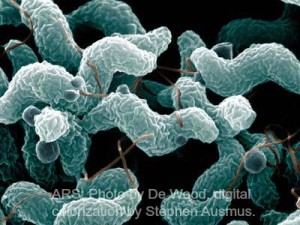 A Campylobacter (usually the jejuni species) infection (campylobacteriosis) is caused by ingesting fecal matter, either from an animal or a human who has campylobacteriosis. Most cases are from contaminated food or water, but outbreaks of illness have been caused by animal contact and transmission at daycare facilities.
A Campylobacter (usually the jejuni species) infection (campylobacteriosis) is caused by ingesting fecal matter, either from an animal or a human who has campylobacteriosis. Most cases are from contaminated food or water, but outbreaks of illness have been caused by animal contact and transmission at daycare facilities.
Less than 500 cells can cause enteritis, an inflammation of the intestine. The cells of bacteria use their spiral shape to penetrate the gastrointestinal mucus. They then adhere to specific cells in the intestine called enterocytes. Once that is done, they make a toxin, and that is what gives an infected human diarrhea, severe cramps, fever, and sometimes vomiting.
Most of our cases have involved people consuming chicken and raw milk contaminated with this bacteria. Our attorneys hold restaurants, retailers, and other companies accountable for selling contaminated food.
These infections can lead to Guillain-Barré syndrome (GBS), a severe illness that can lead to paralysis that may be permanent. GBS patients can die from complications such as respiratory distress syndrome and heart attack. Our attorneys represent GBS victims nationwide.

Free Consultation
Food poisoning lawyer Fred Pritzker has appeared on CBS News, Fox News, and local television stations throughout the nation discussing food poisoning litigation and food safety. He has obtained millions for food poisoning victims, including a recent settlement for $6,425,000.
Do you want to be compensated for medical expenses, pain and suffering, and other damages?
If you are experiencing severe symptoms, you need medical attention immediately. If tests show you have an infection, contact Pritzker Hageman law firm for a free consultation. Our nationally-recognized lawyers can help you understand your legal rights and remedies. Call toll-free 1-888-377-8900 or fill in our online form.
Sources
1. Wallis, M. R. “The pathogenesis of Campylobacter jejuni.” British journal of biomedical science 51.1 (1994): 57-64.
2. CDC pathogen information.